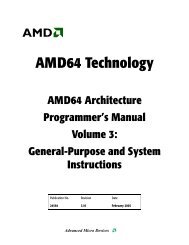DAC vs. MAC - Stanford Secure Computer Systems Group
DAC vs. MAC - Stanford Secure Computer Systems Group
DAC vs. MAC - Stanford Secure Computer Systems Group
- No tags were found...
Create successful ePaper yourself
Turn your PDF publications into a flip-book with our unique Google optimized e-Paper software.
<strong>DAC</strong> <strong>vs</strong>. <strong>MAC</strong>• Most people familiar with discretionary accesscontrol (<strong>DAC</strong>)- Example: Unix user-group-other permission bits- Might set a fileprivate so only groupfriends can read it• Discretionary means anyone with access canpropagate information:- Mail sigint@enemy.gov < private• Mandatory access control- Security administrator can restrict propagation- Abbreviated <strong>MAC</strong> (NOT a message authentication code)
Bell-Lapadula model• View the system as subjects accessing objects- The system input is requests, the output is decisions- Objects can be organized in one or more hierarchies, H(a tree enforcing the type of decendents)• Four modes of access are possible:- execute – no observation or alteration- read – observation- append – alteration- write – both observation and modification• The current access set, b, is (subj, obj, attr) tripples- E.g., (userdm, filegrates.txt,r) if I’m currently reading file• An access matrix M encodes permissible access types(subjects are rows, objects columns)
Security properties• The simple security or ss-property:- For any (S, O, A) ∈ b, if A includes observation, thenlevel(S) must dominate level(O)- E.g., an unclassified user cannot read a top-secret document• The star security or *-property:- If a subject can observe O 1 and modify O 2 , then level(O 2 )dominates level(O 1 )- E.g., cannot copy top secret file into secret file- More precisely, given (S, O, A) ∈ b:if A = r: level(O) is dominated by current-level(S)if A = a: level(O) dominates current-level(S)if A = w: level(O) = current-level(S)
Straw man <strong>MAC</strong> implementation• Take an ordinary Unix system• Put labels on all files and directories• Each user has a security level• Determine current security level dynamically- When user logs in, start with lowest curent-level- Increase current-level as higher-level files are observed- If user’s level does not dominate current, kill program- If program writes to file it doesn’t dominate, kill it• Is this secure?
No: Covert channels• System rife with storage channels- Low current-level process executes another program- New program reads sensitive file, gets high current-level- High program exploits covert channels to pass data to low• E.g., High program inherits file descriptor- Can pass 4-bytes of information to low prog. in file offset• Other storage channels:- Exit value, signals, terminal escape codes, . . .• If we eliminate storage channels, is system secure?
No: Timing channels• Example: CPU utilization- To send a 0 bit, use 100% of CPU is busy-loop- To send a 1 bit, sleep and relinquish CPU- Repeat to transfer more bits• Example: Resource exhaustion- High prog. allocate all physical memory if bit is 1- Low program tries to allocate memory; if it fails, bit is 1• More examples: Disk head position, processorcache/TLB polution, . . .
An approach to eliminating covert channels• Observation: Covert channels come from sharing- If you have no shared resources, no covert channels- Extreme example: Just use two computers• Problem: Sharing needed- E.g., read unclassified data when preparing classified• Approach: Strict partitioning of resources- Strictly partition and schedule resources between levels- Occasionally reapportion resources based on usage- Do so infrequently to bound leaked information- In general, only hope to bound bandwidth covert channels- Approach still not so good if many security levels possible
Declassification• Sometimes need to prepare unclassified reportfrom classified data• Declassification happens outside of system- Present file to security officer for downgrade• Job of declassification often not trivial- E.g., Microsoft word saves a lot of undo information- This might be all the secret stuff you cut from document
Biba integrity model• Problem: How to protect integrity- Suppose text editor gets trojaned, subtly modifies files,might mess up attack plans• Observation: Integrity is the converse of secrecy- In secrecy, want to avoid writing less secret files- In integrity, want to avoid writing higher-integrity files• Use integrity hierarchy parallel to secrecy one- Now only most privilegted users can operate at lowestintegrity level- If you read less authentic data, your current integrity levelgets raised, and you can no longer write low files
DoD Orange book• DoD requirements for certification of securesystems• 4 Divisions:- D – been through certification and not secure- C – discretionary access control- B – mandatory access control- A – like B, but better verified design- Classes within divisions increasing level of security
Divisions C and D• Level D: Certifiably insecure• Level C1: Discretionary security protection- Need some <strong>DAC</strong> mechanism (user/group/other, ACLs, etc.)- TCB needs protection (e.g., virtual memory protection)• Level C2: Controlled access protection- Finer-graunlarity access control- Need to clear memory/storage before reuse- Need audit facilities• Many OSes have C2-security packages- Was C2 Solaris “more secure” than normal Solaris?
• A1 – Verified DesignDivision A- Design must be formally verified- Formal model of protection system- Proof of its consistency- Formal top-level specification- Demonstration that the specification matches the model- Implementation shown informally to match specification
Limitations of Orange book• How to deal with floppy disks?• How to deal with networking?• Takes too long to certify a system- People don’t want to run n-year-old software• Doesn’t fit non-military models very well• What if you want high assurance & <strong>DAC</strong>?
















